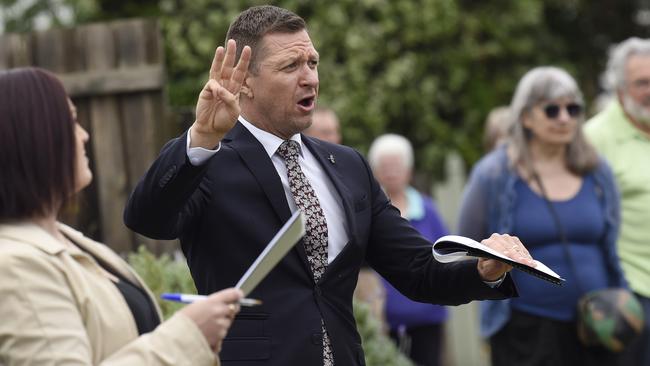Home values weakest since 2008, says CoreLogic
Prices in Sydney now 11pc below 2017 peak, with Melbourne down 7.2pc. Nationally, values fell 4.8pc last year.

National dwelling values dropped 4.8 per cent in 2018, marking the weakest housing market since 2008, new figures show.
According to CoreLogic data, Sydney house and apartment values are down 11.1 per cent from their July 2017 peak, while Melbourne values have dropped 7.2 per cent since they peaked in November 2017.
The new figures show Sydney values have dropped back to where they were in August 2016 while Melbourne values are back to February 2017 levels.
“Perth values are back to levels last seen in March 2009 and Darwin dwelling values are at October 2007 levels,” CoreLogic said.
In the December quarter, national dwelling values were down 2.3 per cent, the largest quarter on quarter decline since the December quarter of 2008.
Today’s data shows Sydney prices fell 8.9 per cent over 2018, while Melbourne was down 7 per cent. Perth values dropped 4.7 per cent and Darwin was down 1.5 per cent. But Hobart values jumped 8.7 per cent and Canberra was up 3.3 per cent.
Regional areas close to capital cities, such as Bendigo and Ballarat near Melbourne, were among the strongest performers.
However CoreLogic’s head of research, Tim Lawless, added: “Although Australia’s two largest cities are the primary drivers for the weaker national reading, most regions around the country have reacted to tighter credit conditions by recording weaker housing market results relative to 2017.
“Such a soft result among the best performing areas highlights that housing market weakness is broadbased and not just confined to Sydney and Melbourne.”
The two exceptions were regional Tasmania, where the pace of capital gains was higher, resulting in a nation-leading 9.9 per cent gain in values, and Darwin, where the annual rate of decline improved from -8.9 per cent in 2017 to -1.5 per cent in 2018.
The strongest capital city subregions were confined to Hobart, Canberra, Brisbane and Adelaide, where housing prices are generally more affordable relative to household incomes, although housing affordability has rapidly deteriorated across Hobart.
The weakest capital city subregions were primarily located across the regions of Sydney, which comprised eight of the top ten weakest capital city markets in 2018.
Despite Sydney’s dominance of the weakest performing areas, Melbourne’s inner east, which includes some of the city’s most expensive properties, topped the list for the largest annual decline in dwelling values.
Dwelling values were down 13.4 per cent across the inner east, followed closely by Sydney’s Ryde, where values were 13.3 per cent lower
The strongest regional performers for 2018 were in Tasmania and Victoria, with subregions in these states comprising seven of the top ten best performing regional markets - including Launceston and Tasmania’s north east, Latrobe and Gippsland, south east Tasmania, Ballarat and Geelong in the top five.
The weakest regional areas comprise a broader range of locations from agricultural regions where drought conditions and low demand are weighing down the market, through to previously strong markets adjacent to Sydney such as Newcastle and Lake Macquarie, Illawarra, the Southern Highlands and Shoalhaven.
CoreLogic’s Cameron Kusher predicts Sydney and Melbourne house and apartment values could drop further with a slow recovery not expected until later this year or early 2020.
Access to finance is likely to remain the most significant barrier to an improvement in housing market conditions in2019.
“Lenders are understandably risk averse against a backdrop of falling dwelling values, high household debt, rising supply and heightened regulatory focus following the banking royal commission,” said Mr Lawless.
A burst housing bubble remains the greatest risk to the nation’s $1.3 trillion economy, according to the Organisation for Economic Co-operation and Development, with a hard landing possibly for the already-stagnant property market.
House prices and auction activity have fallen gradually since late 2017, with Reserve Bank Assistant Governor Christopher Kent blaming “unnecessary” credit tightening in December for further threatening the market.
Last month the Australian Prudential Regulation Authority announced it was removing a cap on interest-only loans for residential property, on the grounds that the measure had reached its objective of curbing higher-risk lending practices.
APRA said the cap had “led to a marked reduction in the proportion of new interest-only lending, which is now significantlybelow the 30 per cent threshold”.
Mr Lawless said he expects housing market conditions to continue to slide over the coming year.
“With a federal election likely to be held sometime in May, we may see a further negative impact on confidence, especially among investors who will be impacted by changes to taxation policy should there be a change of government,” he said.
“On a positive note, interest rates are set to remain close to historic lows and migration is likely to remain high (albeit lower than last year) which will help to keep a floor under housing demand.”
With AAP




